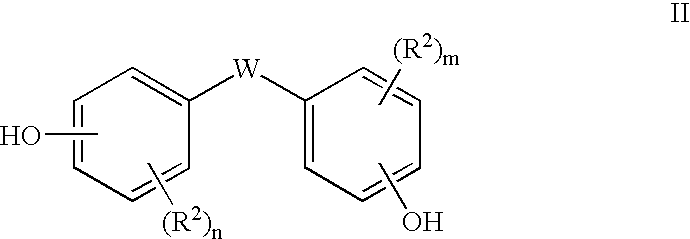Method for making stable, homogeneous melt solutions
a technology of stable and homogeneous melts and solutions, applied in the direction of organic compounds/hydrides/coordination complex catalysts, physical/chemical process catalysts, chemical instruments and processes, etc., can solve the problems of difficult to achieve a homogeneous melt for use as feedstock, negatively affecting the color, stability and flow properties of product polycarbonate, and almost always accompanied by unwanted side reactions
- Summary
- Abstract
- Description
- Claims
- Application Information
AI Technical Summary
Problems solved by technology
Method used
Image
Examples
examples
[0053]The following examples are set forth to provide those of ordinary skill in the art with a detailed description of how the methods claimed herein are evaluated, and are not intended to limit the scope of what the inventors regard as their invention. Unless indicated otherwise, parts are by weight, and temperature is in degrees centigrade (° C.).
Melt Solution Formation Examples 1-5
[0054]Stable, homogeneous melt solutions were prepared in a single neck, round-bottomed flask equipped with a magnetic stir bar. The flask was charged under ambient conditions with diaryl carbonate, a high melting bisphenol, tetrabutylphosphonium acetate catalyst, and optionally bisphenol A, in the molar ratios indicated in Table 1 and in amounts sufficient to produce a total weight of the stable, homogeneous melt solution of between about 5 and about 40 grams. The catalyst was added as a solution in water containing about 40 percent by weight tetrabutylphosphonium acetate (TBPA). The volume of the TBP...
PUM
| Property | Measurement | Unit |
|---|---|---|
| Temperature | aaaaa | aaaaa |
| Temperature | aaaaa | aaaaa |
| Dimensionless property | aaaaa | aaaaa |
Abstract
Description
Claims
Application Information
 Login to View More
Login to View More - R&D
- Intellectual Property
- Life Sciences
- Materials
- Tech Scout
- Unparalleled Data Quality
- Higher Quality Content
- 60% Fewer Hallucinations
Browse by: Latest US Patents, China's latest patents, Technical Efficacy Thesaurus, Application Domain, Technology Topic, Popular Technical Reports.
© 2025 PatSnap. All rights reserved.Legal|Privacy policy|Modern Slavery Act Transparency Statement|Sitemap|About US| Contact US: help@patsnap.com



